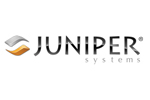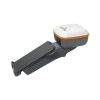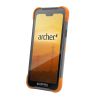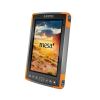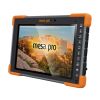Juniper Geode GNSS Receivers
Features
- Compatible with iOS, Android, and Windows devices
- Intuitive and easy operation, one-button simplicity
- All day battery life for long work days in the field
- Free ground shipping
- Expedited repair and warranty service
- Lifetime technical support
- More
Scalable Accuracy
The Geode GNS3 provides sub-meter, sub-foot, decimeter and centimeter accuracy options which include SBAS Corrections, RTK, Atlas, and the new Galileo High Accuracy Service.
Open Interface (BYOD)
Use Geode with any of Juniper Systems' handhelds or with your own iPhone™, iPad™, Windows®, or Android™ device.
All-day Battery Life
The Overtime Technology battery provides enough power for long workdays, while conserving power in extreme temperatures.
Simple to Use
It's "one button simple" design provides intuitive and easy operation.
Compact Size
Small and lightweight, the Geode is easy to pack around all day.
All-In-One Design
The inside of the Geode contains the receiver, antenna, and battery, making it easy to carry around and mount without a mess of wires.
Juniper Rugged™
Designed to withstand harsh environments for consistently reliable performance.
Galileo High Accuracy Service (HAS)
The new GNS3H model of the Geode family adds support for the Galileo High Accuracy Service (HAS) to provide free, worldwide 20cm accurate positioning. The Galileo HAS is currently in Initial Phase, meaning that the performance and time standards are currently relaxed so that the EUSPA (European Union Agency for Space Programme) can complete their design and testing to complete the Final Phase of operations with better than 20cm performance in under 5 minutes convergence time (see excluded areas in map below). Simply apply a multi-frequency upgrade to any GNS3H receiver and you have instant access to 20cm real-time location accuracy without any additional subscriptions, downloads or software. The Galileo High Accuracy Service provides precise corrections in the Galileo E6B data signal so that Galileo and GPS signals can achieve real time positioning performance of better than 20cm in nominal conditions. With Galileo HAS, Sub-meter becomes Sub-foot as the new standard for free and open global GNSS positioning.
RECEIVER
- Receiver Type: multi-frequency multi-constellation and L-band capable
- Signals: GPS: L1CA, L1P, L1C, L2P, L12P, L2C, L5,
GLONASS: G1, G2, BeiDou: B1, B2, B3,
GALILEO: E1BC, E5a, E5b, E6b and
QZSS: L1CAm, L1C, L2C, L5 - Channels: 800+
- SBAS Support: 3-channel parallel tracking
- L Band: Atlas worldwide 1525-1560 Mhz
(with subscription) - Update Rate: 1 Hz standard, up to 10Hz and 20 Hz options
- Galileo High Accuracy Service support (GNS3H, with multi-frequency enabled)
ACCURACY
- SBAS: 30 cm HRMS, <60 cm 2DRMS
- RTK: 1 cm RMS
- Atlas (95%): H10:10cm, H30:30 cm, Basic:
50cm (requires subscription)
GALHAS (95%): 20cm - Autonomous: 1.2 meters HRMS
- Cold Start: <60 sec typical (no almanac)
- Reacquisition: 15 sec Atlas, all others <1sec
COMMUNICATIONS
- Bluetooth® 5.1 SPP, IAP2, EAP
- Bluetooth Range: Class 1 Long Range
- Ports: USB Type-C; Serial RS232C DB-9
- Serial Baud Rates: 4800-115200
RECEIVER PROTOCOLS
- Data I/O Protocol: NMEA 0183, Crescent Raw Binary (proprietary)
- Correction I/O Protocol: Hemisphere GNSS
Proprietary, ROX, RTCM v2.3, RTCM v3.2, CMR,
CMR+ - Other: 1PPS Timing Output, Speed Pulse,
Event Marker Input (optional)
POWER
- Input Voltage: 5VDC @ 2A USB
- Power Consumption : 1.7-2 W nominal
- Overtime Technology™ Battery:3.6V 6000 mAh Li-ion (GNS3M/GNS3H) 10 hours, (GNS3S) 16 hours
- Charging Time: Less than 4 hours
ANTENNA
- Internal precision single/multi-frequency with integrated ground plane
- External Antenna Port: MCX type, 50 ohm 15VDC @ 45 mA maximum (GNS3M)/20mA maxiumum (GNS3S)
JUNIPER RUGGED™
- Operating Temp: -20 C to +60 C
- Storage Temp: -30 C to +60 C
- Meets or Exceeds MIL-STD 810G (Drop, Vibration, Temperature, Ingress Protection)
- Enclosure Rating: IP68 (1.4 meters for 30 min)
RECEIVER UPGRADES
- 10 Hz Data Rate
- 20 Hz Data Rate
- Multi-Frequency
- Atlas Basic
- Atlas H30
- Atlas H10
- Athena RTK Engine
DIMENSIONS
- 110x110x57mm (4.36x4.36x2.5in)
- GNS3S Weight: 365g (12.9oz)
- GNS3M/GNS3H Weight: 405g (14.3oz)
- Mount: ¼ x 20 camera stud and M4 AMPS diagonal
GEODE GNS3 COMPATIBILITY
- GeodeConnect™ software provides configuration, communications setup, and receiver settings
- Windows® 10/11
- Android™ 8 and above
- iPhone and iPad
- (1) Geode GNSS receiver with integrated antenna and battery
- (1) USB Type-C to USB Type-C cable
- (1) 5/8 x 11 pole mount adapter
- (1) USB charger
In The News
Wildfire Prevention in the Sierra Nevada Region with the Yuba Watershed Institute
Though recent wildfires have sparked new conversations about wildfire management and response, groups like the Yuba Watershed Institute have been monitoring the forests and water resources of the Sierra Nevada region for decades, managing approximately 5,000 acres of land with the Bureau of Land Management (BLM) and about 7,000 acres in private land partnerships. The goal of the Institute is to work with local communities and land agencies to improve watershed and forestry management through informed practices and public outreach. The goals of the Yuba Watershed Institute are three-fold: Improve the ability of fire suppression agencies like the California Department of Forestry and Fire Protection ( CAL FIRE ) and the US Forest Service.
Read MoreFrom Paddles to Phytoplankton: Studying Vermont’s Wildest Lakes
For six months of the year, Rachel Cray, a third-year PhD student at the Vermont Limnology Laboratory at the University of Vermont, lives between a microscope and her laptop, running data. For the other six months, she is hiking and canoeing four of Vermont’s lakes, collecting bi-weekly water samples. Cray studies algal phenology across four lakes in Vermont, US, that have low anthropogenic stress—or in other words, are very remote. Funded by the National Science Foundation Career Award to Dr. Mindy Morales, the lakes Cray researches part of the Vermont Sentinel Lakes Program, which studies 13 lakes in the area and, in turn, feeds into the Regional Monitoring Network, which operates in the Northeast and Midwest US.
Read MoreReimagining Water Filtration: How Monitoring and Science Enhance FloWater Filtration Systems
Over 50% of Americans think their tap water is unsafe , according to the Environmental Working Group (EWG). Other recent surveys have found that number to be as high as 70% of persons surveyed. Whether due to increased public awareness of water quality issues or confusion about how municipal water sources are regulated, there is a clear distrust of tap water in the United States. According to industry expert Rich Razgaitis, CEO and co-founder of the water purification company FloWater, this issue creates a damaging cycle. Razgaitis explained that the health and environmental problems associated with contaminated water aren’t the only issues. As people become increasingly aware that some tap water is unsafe, they resort to bottled water.
Read More







